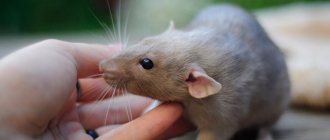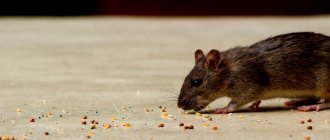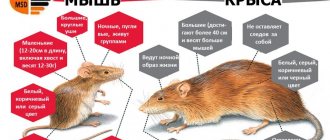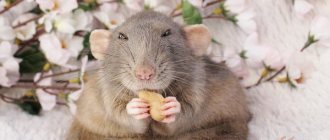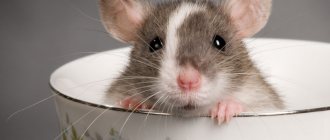Rats are dangerous mammals. Neighborhood with them is fraught with damage to food, electrical wiring and even building materials. Rodents easily chew through foam plastic and wooden structures, and rats encroach on insulation and concrete. It is not always possible to identify the location of their settlements. It is not difficult to recognize rats by their appearance, but these animals are distinguished by their caution, intelligence and lead a secretive lifestyle. Rat tracks in the snow have obvious differences from other small animals and from them you can determine the culprit of the prints. Tracking can be a real help in finding nests, and is also useful for rat hunters.
The structure of rat paws
The most common rat is the Pasyuk, whose tracks are very similar to all mouse-like ones. However, the paws are slightly larger.
Rat front paws
The size of the rat's footprint reaches 2*1.5 cm. The fingers are up to 10 mm long, ending in short sharp claws. If the prints are clear, the plantar tubercles will be clearly visible.
Hind legs of rats
On a large print measuring 4 cm, only the front half is visible. All 5 fingers are visible, the side ones are protruding.
Population and species status
Since the beginning of the third millennium, black rat populations have declined markedly and become fragmented. According to experts, black rats have begun to be replaced by more fertile gray rats (pasyuki). And yet, despite the high fertility, rat populations do not go beyond the “Red Line”, since their numbers are controlled by a number of important factors.
Firstly, the number of these animals directly depends on the availability of food and shelter. Lack of food immediately leads to a decline in population. In addition, there are special rat control services. The number of these animals is constantly declining as a result of certain diseases, as well as hunting by many predators. Therefore, despite their high fertility, which leads to constant surges in their numbers, natural factors, as well as rat control services, are doing their job.
Today, most species of rats are not even close to the risk zone, although there are very rare species that are protected. As a rule, the number of rare species largely depends on the life activity of people, who are developing more and more new territories that are related to the natural habitat of these species.
Franklin Island is home to a very rare species of “House Rats.” Due to the fact that the species lives in a limited area, it is classified as an endangered species. Currently, only about 2 thousand individuals live in this territory. Annual deforestation and fires can reduce kangaroo rat populations.
Paw prints of rats depending on the method of movement
In a dark room, rat tracks are located in pairs and alternately. On one side there is a print of the front and back paws, then in the same sequence on the other side. It feels like the animal is sneaking along a thread.
Ricocheting jumps - when the rat pushes off with its front legs, then with its hind legs, and lands on its front legs. Another type of jumping is when the rat groups its body like a spring, pushes off with its hind legs and brings them in front of its front ones.
The clearest tracks are visible in the snow. The pasyuk's leisurely gait leaves traces at large intervals. They look splayed out.
Rat tracks.
Features of the movement of rats in winter
It is in the snow that rat paw prints are easiest to recognize. The type of movement of rodents depends on the height of the snow cover.
In the snowdrifts
Traces of rat jumps.
The rat jumps in the snowdrifts, but the depth of the snowdrifts creates obstacles. In this regard, the traces themselves change.
The interval is reduced to 20 - 40 cm. The path is about 7 cm. Traces of the tail are visible. In large snowdrifts, he jumps once to dive deeply and begin to make his way. It resembles trenches. The prints are almost invisible.
In shallow snow
In such conditions, the rodent has several ways of moving. The most common is horse racing. The push is made with the front paws, and then with the hind paws. This promotes body extension and tuck.
Feeling the ground, he pushes off again. A calm state implies uneven tracks. A print that is spread apart and not parallel indicates the presence of mice or voles.
No trace of a tail. Moves calmly. When chasing prey, the distance is 70 cm. Wild rats jump, pushing well off the ground. Line width up to 8 cm.
Footprints of other members of the genus
Traces of small rodents can be confused with those of rats by inexperienced trackers, but with large animals you will have to really rack your brains. They are somewhat similar, but have characteristic differences.
Mouse
Maneuverability is not typical for a small animal. They always move through the snowdrifts by jumping. Mouse tracks in the snow are clearly visible. Leaves clear marks on the front and hind legs, and a long, thin tail.
Jumping is similar to a squirrel, if not for the tail. A body imprint remains in the snowdrifts, which does not exceed 5 cm. The distance between jumps is from 5 cm to 50 cm. The mouse pushes off with its hind legs, jumps, and places them in front.
Mouse tracks in the snow
The locomotion mechanism of many species of mice resembles the gait of a rat, but the imprint of the limb is different. In a large rodent it is larger. There are no small rats in winter; baby rats appear only in spring.
Weasel
Always found where mice hunt. The weight of the animal is about 100 g. It practically does not fall into the snow and leaves superficial, light prints. The size of one paw is 1.5*1 cm. The distance between jumps is up to 35 cm. Often the front and hind limbs step into the same hole, creating deeper marks in a checkerboard pattern.
Mouse paw prints
Mice get along well with people in the city and villages. They prefer to feed on seeds and vegetative parts of plants. Around people, they like to spoil cereals, dairy products, and stocks of meat products.
There is nowhere to see their traces in the house, unless, of course, there is a layer of dust. They can be tracked in the barn and on the street. Although the signs may vary slightly depending on the type of mouse, there are some common signs.
Features of mouse tracks depending on the type of movement
Most often, the mouse moves by jumping , so the prints look like a trapezoid, where the large hind legs protrude forward, and the small front ones are slightly behind and next to each other. At the same time, traces from the tail remain behind.
If mice move at a gallop , then the tracks are mincing, with small intervals, followed by a pair of footprints. At the same time, the tail does not leave marks; the mouse holds it suspended. In the dark, steps are more careful, the gap is greater.
Mouse tracks.
Extraordinarily loving
But no matter how many rats humanity destroys, there are not just a lot of them, there are a lot of them. Of course, no one is conducting a census of the “rat population”. But biologists have their own methods of counting.
And so they say: in warm countries there are 3-4 rats per person (and some believe as many as 9!). And in New York the ratio is one to one. So think about who is our king of nature - a man or a rat.
Rat.
creativecommons.org
And why all? These rodents are extremely fertile and loving. They have the ability to give birth to babies already at the age of three months, although they usually “puppy” (or “rat”?) closer to a year.
And during the fertile period they mate up to 500 times (!) with different gentlemen. Three weeks after this exciting activity, from 6 to 20 babies are born. According to some estimates, in just 2-3 years of its short life, a rat is capable of producing up to 6 thousand offspring. And each of these “fruits of love” will also produce no less - just give it.
Moreover, they are not threatened with hunger: in warehouses and in human cellars there is always something to profit from.
Rat.
visualhunt.com
How to find a rodent nest by following their tracks
Mouse nest.
Following the route, you can find the nest. The traces of the pasyuks are clearer, but the distance between them is greater. They press their paws harder. Wood mice and voles have less clear markings and are closer together.
The places where the nests are located are covered with fallen leaves or rubbish. The entrance diameter is up to 5 cm. It is easy to check whether rodents live there. You need to roll up the newspaper and place it in the hole. Having pulled out the crumpled and splashed paper a day later, it becomes clear that there are inhabitants inside and it is necessary to take measures to destroy it.
It can be gigantic
An ordinary person understands a rat as the most common species on the planet - the Norwegian, or gray (Pasyuka), and its domesticated relative, which is bred in homes.
There are legends that these creatures grow almost to the size of a cat. This is not true - pasyuki do not grow. The largest of them rarely reach 50 centimeters including the tail and gain 450 grams.
But... In nature, there is not only this type of rat. In New Guinea, during the filming of a BBC nature film in 2009, a completely new species was discovered in the crater of the Bosavi volcano.
It was named the Bosavi woolly rat. This miracle of nature reaches 82 centimeters (including the tail). This “rat” weighs about 1.4 kg. And she is not at all afraid of a person whom she has never seen during her volcanic life.
Rat.
creativecommons.org
Rat.
creativecommons.org
Rat.
visualhunt.com
Behavior and intelligence
The house mouse is the most common rodent living in human housing. Over many years of coexistence, its diet has changed significantly; the animal switched from cereals and nuts to plant and animal products that people eat. In the summer, mice can live in the fields, picking up grains, but by mid-autumn they will certainly move closer to humans and a warm home.
The intelligence of house mice is quite low, they are also not very careful, so they easily fall into even the simplest mousetraps. The population of these rodents is maintained only due to their rapid reproduction - females give birth to offspring every month, up to 100 mice per year. Their body length is 7-8 cm, in rare cases with good nutrition - up to 10 cm, weight - 25-40 grams
Thanks to such miniature sizes, the mouse is able to squeeze through even a centimeter gap
Their body length is 7-8 cm, in rare cases with good nutrition - up to 10 cm, weight - 25-40 grams. Thanks to such miniature dimensions, the mouse is able to squeeze through even a centimeter gap.
Interestingly, the colors of mice depend on the geographic location of their residence. In southern and central Russia, rodents with light silvery skin are common; in Siberia, their fur is more brown than gray. The line between colors is becoming increasingly blurred over time - animals travel on all types of transport, so sometimes you can see an animal of an unusual color.
If this rodent is caught at the scene of a crime, it will freeze, assess the situation and run away only if it sees danger. Catching a rat with your hands or throwing a blanket over it is not a good idea. They are aggressive and will fiercely defend themselves if they find themselves in a hopeless situation.
The mental abilities of large and small rodents also differ significantly. The Rat is much smarter and smarter. When kept as a pet, it becomes attached to its owner and is even able to respond to a nickname. Getting rid of these rodents is more difficult; they will never eat suspicious food or climb into a trap.
Mice live in houses much more often; thanks to their small size, it is easier for them to enter a room, hide and get the right amount of food. Rats prefer to settle in places where people visit less often: in basements, granaries, barns, chicken coops.
Mice and rats cannot coexist in the same area. When the pasyuks arrive, one part of the small rodents immediately changes their place of residence, and the other turns out to be food for their older brothers.
We suggest you read How to make apple marshmallows
Pregnancy and childbirth
Signs of pregnancy will show up in your rat's behavior during the first few weeks. The rat will dominate the other females in the cage, and will usually become alpha instantly and be very restrictive of others, taking food away from them. Typically, other rats will "know" that the female is pregnant and will give her the food she needs, as well as make space for her if necessary.
After the first 14 days, weight gain may be noticed and the rat may look like it has swallowed a tennis ball. But if the rat is large and pregnant with small offspring, a noticeable change in weight may not occur.
Pregnant rat
Most rats give birth during the 21st night of gestation and are not likely to give birth early, but sometimes females give birth until the 22nd or 23rd day
If a pregnant rat does not give birth after these days, you should pay attention to this, as this may indicate possible problems
Caring for a pregnant rat
It is not a good idea to place water and food at different levels, a pregnant female should have everything she needs as close to her nesting site as possible so that she does not walk too much, she does not need it.
One must be very careful when handling a pregnant female as this may harm the babies inside her as well as disturb her personal comfort. You need to move your rat to a separate cage about a week before she gives birth.
This will allow her to have her own space and feel relaxed. The “maternity hospital” for a rat should be cozy and large enough so that she and her children can live there for about 4-5 weeks
You need to move your rat to a separate cage about a week before she gives birth. This will allow her to have her own space and feel relaxed. The “maternity hospital” for a rat should be cozy and large enough so that she and her babies can live there for about 4-5 weeks.
The place for the rat to give birth and for the babies to live should be warm and cozy
During pregnancy, the diet should contain normal foods in the usual quantities, but it is supported by additional proteins, including meat, fish, nuts, bread soaked in milk, etc.
Rat Family Lifestyle
To understand why rats are dangerous, it is worth understanding how they live and reproduce. It is quite possible to call gray predator mammals long-lived. Let's add to this intelligence, a sense of responsibility and a family lifestyle. Rodents of this breed are divided into 64 species. But only two are capable of living next to a person and harming him - synanthropic ones: the black and white rat. They can be identified not only by color. As they say, in the dark and in a frightened state you won’t look too closely at the color. But still, the gray individual is larger than the black one, and the shape of the tail and front parts are sharply different. There are no more differences. If you buy a rat in stores yourself, you don’t have to be afraid - these two species cannot be tamed. Habitat:
- dump;
- trash cans and garbage chutes;
- abandoned houses and drainpipes;
- collectors and warehouses;
- sewerage system and breeding area for poultry and animals.
Rats are the largest rodents from the mouse family, which are one of man's long-time neighbors.
If a sexually mature individual has appeared under the floor, then we can confidently say that babies will appear within six months. Moreover, the female breeds at least 7-8 babies at a time. In addition to excellent fertility, rat droppings have a 100% survival rate. On average, the lifespan of rodents reaches 10 years or more. The whole family obeys only one main rat. In their kubla (as the family’s place of residence is called), one can distinguish the main gathering place and overnight stay, a warehouse. The “pantry” contains non-perishable products. This is how rodents provide themselves with wintering.
They are distinguished by increased survival, as they perfectly sense poisons and danger. Despite their rather large size, they sneak into cracks and holes, connections between wall slabs in multi-storey apartments.
Differences in nutrition
Both species are omnivores, but rats and mice can be distinguished by their feeding habits. Both of them are predators. They can attack other animals and insects and eat their meat.
Rats are more aggressive. Wild individuals hunt more often and mainly in packs. But they can attack alone. Small and weakened animals, including mice, often become victims of rats. When there is a shortage of food, rodents also attack each other. More often than mice, they feed on human household waste, so entire flocks often live in landfills.
Rats
Mice eat meat less often. These rodents prefer plant foods. They regularly replenish their supplies with leftover vegetables, seeds, and cereals. But this does not mean that mice will refuse meat. They will eat it with pleasure, but they will not hunt for it.
Mouse
Difficulty getting rid of
Rats are quite tenacious, and it is not possible to destroy them using just one method. Their keen sense of smell gives them advantages over all types of pests. You can’t fool them with bait, and even more so using standard poisons. Folk "therapy" of housing has an extensive knowledge of recipes for controlling rodents. Therefore, experts recommend using two or three options on your own at the same time.
Ash and glass
Both ingredients are excellent ways to kill adults and small creatures. The rats will fly off for their fur. Therefore, ash or broken glass that gets into the crumbs, almost into dust, settles on it and, when licked, ends up in the animal’s stomach. They will not be able to withdraw in the usual way. The gravity prevents the rats from moving and they die. But after the death of relatives because of this, rodents will no longer enter a room with such mounds on the floor.
Milk with poison
Agricultural experts propose a deceptive maneuver using sweet milk. A bowl of milk is placed in the same place regularly for three to four days. But without the presence of toxic substances. As soon as the rat gets used to the fact that there is sweetness here and can be consumed without problems, it will come with its full flood. Now you can add poison. The honey kills the smell, and the creature drinks the liquid death on its own.
Intelligence difference
If we compare the intelligence of two types of rodents, then mice are much inferior to rats, which are more intelligent. Scientists equate their intelligence to that of cats and even dogs. These are careful animals.
They assess the area they intend to settle in, study it for potential dangers, and leave if they see a serious threat. Other amenities are also important to them: they know how to assess the temperature of the room and the quality of food. If the food seems dangerous to them, they will not take risks.
Rat
Mice are not capable of such actions. They assess the territory worse and easily eat poison. Small rodents are more likely to become victims of predators because they leave behind many traces and cannot identify potential danger.
The difference in intelligence is also noticeable in the fact that mice gather in packs less often, they do not have a clear hierarchy and defined roles. Rats always live together. Each individual in the pack has its own responsibilities. For example, before settling into a new territory, a small group of rodents must explore it. If she seems safe to them, then the rest of the pack will follow.
Rats
Important! Rats are very aggressive. They often attack mice and kill their relatives if they feel threatened by them. Sometimes they attack weakened individuals if the flock lacks food.
Rats easily recognize danger and try in every possible way to avoid it. When they see a predator, they run away to a previously found shelter. Mice act chaotically, rushing around in circles, so they get caught more often.


